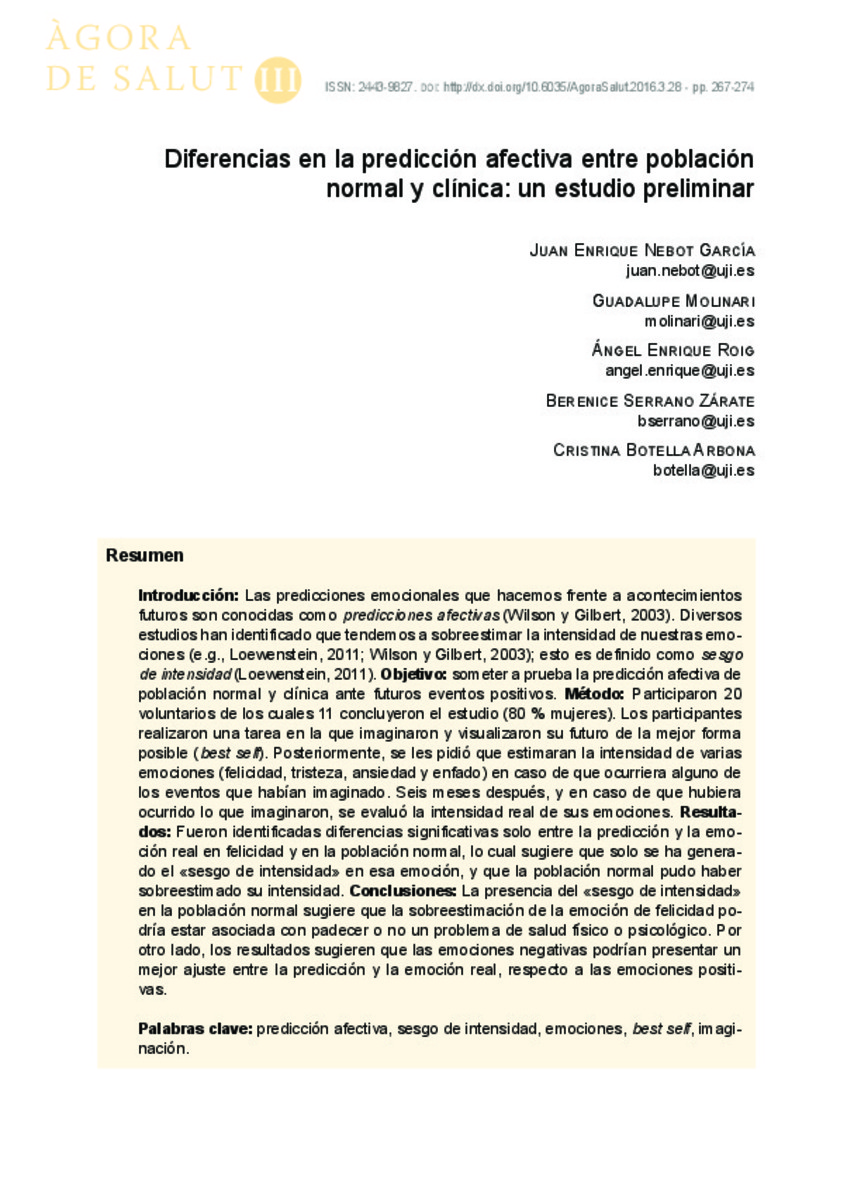Mostrar el registro sencillo del ítem
Diferencias en la predicción afectiva entre población normal y clínica: un estudio preliminar.
| dc.contributor.author | Nebot-Garcia, Juan Enrique | |
| dc.contributor.author | Molinari, Guadalupe | |
| dc.contributor.author | Enrique Roig, Angel | |
| dc.contributor.author | Serrano-Zárate, Berenice | |
| dc.contributor.author | Botella, Cristina | |
| dc.date.accessioned | 2016-03-30T08:46:11Z | |
| dc.date.available | 2016-03-30T08:46:11Z | |
| dc.date.issued | 2016 | |
| dc.identifier.issn | 2443-9827 | |
| dc.identifier.uri | http://hdl.handle.net/10234/155709 | |
| dc.description.abstract | Introducción: Las predicciones emocionales que hacemos frente a acontecimientos futuros son conocidas como predicciones afectivas (Wilson y Gilbert, 2003). Diversos estudios han identificado que tendemos a sobreestimar la intensidad de nuestras emociones (e.g., Loewenstein, 2011; Wilson y Gilbert, 2003); esto es definido como sesgo de intensidad (Loewenstein, 2011). Objetivo: someter a prueba la predicción afectiva de población normal y clínica ante futuros eventos positivos. Método: Participaron 20 voluntarios de los cuales 11 concluyeron el estudio (80 % mujeres). Los participantes realizaron una tarea en la que imaginaron y visualizaron su futuro de la mejor forma posible (best self). Posteriormente, se les pidió que estimaran la intensidad de varias emociones (felicidad, tristeza, ansiedad y enfado) en caso de que ocurriera alguno de los eventos que habían imaginado. Seis meses después, y en caso de que hubiera ocurrido lo que imaginaron, se evaluó la intensidad real de sus emociones. Resultados: Fueron identificadas diferencias significativas solo entre la predicción y la emoción real en felicidad y en la población normal, lo cual sugiere que solo se ha generado el «sesgo de intensidad» en esa emoción, y que la población normal pudo haber sobreestimado su intensidad. Conclusiones: La presencia del «sesgo de intensidad» en la población normal sugiere que la sobreestimación de la emoción de felicidad podría estar asociada con padecer o no un problema de salud físico o psicológico. Por otro lado, los resultados sugieren que las emociones negativas podrían presentar un mejor ajuste entre la predicción y la emoción real, respecto a las emociones positivas. | ca_CA |
| dc.description.abstract | Introduction: The forecast that we do about the emotions in the face of future events are known as «affective forecasting» (Wilson & Gilbert, 2003). Several studies have found that we tend to overestimate the intensity of our emotions (e.g., Loewenstein, 2011; Wilson & Gilbert, 2003); this is defined as «intensity bias» (Loewenstein, 2011). Objective: To test the affective forecasting in normal and clinic population in the face of positive future events. Method: Twenty volunteers participated of which only eleven completed the study (80 % female). The participants carried out a task in which they imagined and visualized their future in the best possible way (best self). Later, they were asked to forecast the intensity of various emotions (happiness, sadness, anxiety, and anger) in case of any of the events they imagined would happen. Six months later, and in case that the event they imagined happened, the real intensity of their emotions was assessed. Results: Significant differences were found between the predicted emotion and the real emotion in happiness and in the normal population; this suggests that only was generated the «intensity bias» in that emotion and that the normal population could have overestimated its intensity. Conclusions: The presence of the «intensity bias» in the normal population suggests that the overestimation of happiness could be associated with suffering or not a physical or psychological health problem. Furthermore, the results suggest that the negative emotions could present a better fit between the predicted emotion and the real emotion compared to positive emotions. | ca_CA |
| dc.format.extent | 8 p. | ca_CA |
| dc.format.mimetype | application/pdf | ca_CA |
| dc.language.iso | spa | ca_CA |
| dc.publisher | Universitat Jaume I | ca_CA |
| dc.relation.isPartOf | Àgora de salut vol. III | ca_CA |
| dc.rights | © Del text: els autors i les autores, 2016 © D’aquesta edició: Publicacions de la Universitat Jaume I, 2016 | ca_CA |
| dc.rights.uri | http://creativecommons.org/licenses/by-sa/4.0/ | * |
| dc.subject | predicción afectiva | ca_CA |
| dc.subject | sesgo de intensidad | ca_CA |
| dc.subject | emociones | ca_CA |
| dc.subject | best self | ca_CA |
| dc.subject | imaginación | ca_CA |
| dc.subject | affective forecasting | ca_CA |
| dc.subject | intensity bias | ca_CA |
| dc.subject | emotions | ca_CA |
| dc.subject | imagination | ca_CA |
| dc.title | Diferencias en la predicción afectiva entre población normal y clínica: un estudio preliminar. | ca_CA |
| dc.type | info:eu-repo/semantics/article | ca_CA |
| dc.identifier.doi | http://dx.doi.org/10.6035/AgoraSalut.2016.3.28 | |
| dc.rights.accessRights | info:eu-repo/semantics/openAccess | ca_CA |








